Area Targets: A Tango’s Dream
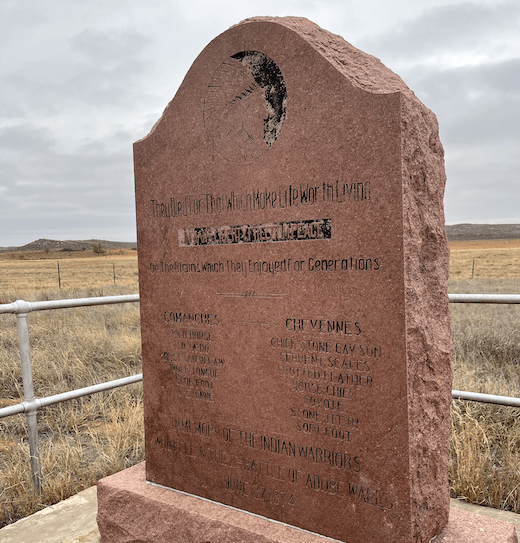
“They couldn’t hit an elephant at this dist–”
–Last words of Union General John Sedgwick, 09 May 1864
Question: How far away can you hit something with your rifle?
One answer might be, “How big is it?”
A single person or small object such as a narrow window is called a Point Target.
A group of people or an enemy camp is an Area Target.
Point Targets
Just about every Marine with a rifle can hit a motionless, man-sized target on a shooting range at, say, 450 meters, even without a scope.
Key word, “motionless.”
Troops in contact are not likely to be standing motionless like an E-series “green Earnie” target on a firing range. As the late, great Bill Dreeland, US Customs and Gunsite firearms instructor told us,
“If you are in a gunfight and you are standing in one place, it’s possible you may be doing something wrong.”
But the farther away the enemy, is, the more secure we feel we are, the more likely we are to be just standing or sitting around.
One night when my friend Max was in Iraq, a sentry was on duty in a sandbagged LP / OP (listening post / observation post) in the wider tower on the left in this photo of the Ottoman fortress of Tal’Afar.
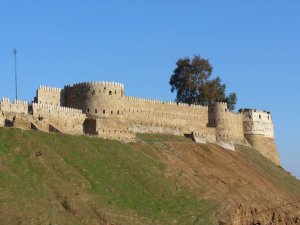
He must’ve felt fairly secure, behind the ramparts and sandbagged walls of that LP / OP.
That was not long after Revenge of the Sith came out. Perhaps he was remembering Obi-Wan’s words:
“It’s over, Anakin. I have the high ground.”
That sentry certainly had the high ground up there on that eastern wall. Besides, the “bad” part of town was more than a quarter of a mile away, on the other side of a wadi, and the gaps in the crenelated ramparts, augmented by sand bags, were no more than half a meter wide.
He felt so safe, he lit up a cigarette.
An insurgent sniper with a PSL rifle shot him through a gap in the rampart, from an estimated distance of 250 – 300 meters.
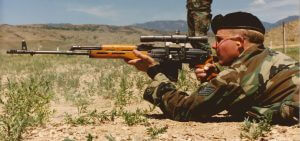
It’s true: smoking is bad for your health. Especially at night, when some of the bad guys have magnified optics on their rifles.
Effective Range
When the ordnance types do the statistical analyses to arrive at an effective range for any given weapons system, they’re talking about the distance at which the average soldier can hit a target, anywhere on the target, with more than half of his or her shots.
On paper, this so-called “average” soldier can hit an Area Target at 800 meters with an M16A2, and at 600 meters with an M4.
For example, one might shoot at an enemy artillery piece or mortar section 600 meters away, not to hit any particular cannon cocker (Point Target), but rather to force the enemy gun bunnies there (the entire group constituting an Area Target) to seek cover.
If you actually hit one of them, that would be a bonus, but it is not to be expected, nor really even necessary. As long as they are hiding from your harassing fire, and not manning their weapons, they and their cannon or mortar are, temporarily at least, out of the fight.
Which is all well and good, if you’re in the Army or Marines. What does it have to do with your day-to-day life here in the ‘States?
Case Studies of Attacks on Area Targets in the United States
Jonesboro, Arkansas
On 24 Mar 1998, two junior high students attacked the Westside Middle School in Jonesboro, AR. One pulled a fire alarm. The other was waiting on a nearby hillside to ambush them as they evacuated the school. The alarm-puller ran up there and joined him.

Students and educators evacuating the school on the right side of this image were shot from the wooded hillside to the left. Four students and a teacher (Shannon Wright) were killed, and 10 others wounded, about where I was standing when I took this photo on 09 Oct 2022. Each of the students were Point Targets; the group of students was an Area Target.
The USA Today said that the shooter(s) were “about 100 yards away,” but the distance to the wooded high ground did not seem quite that far when I walked that terrain two decades later.
Seven of their weapons were handguns; most people have difficulty hitting a motionless target with a handgun past 25 yards. They had three rifles: a Remington 742, a Universal M1 Carbine clone, and a Ruger .44 mag. Either of those rifles is quite capable of hitting Point Targets at less than a hundred yards–if the operator knows what s/he is doing.
They may have targeted individuals (the media said that two in the crowd were “ex-girlfriends”–whatever that means in middle school), but it’s more likely they just shot into the group of 87 students and 9 teachers. The killers fired 30 rounds into the crowd, hitting 15 people.
Navy SEALS, they were not.
Some were able to seek shelter from the killers in the gym.

The Jonesboro pair may have been inspired by a sniping attack in Stamps, Arkansas the previous December (15 Dec 1997). A wannabe sniper shot a pair of students in the Stamps High School parking lot from a forested area nearby. The two Stamps HS victims were standing and talking, and constituted a pair of Point Targets, rather than an Area Target.
Las Vegas, Nevada
On 01 Oct 2017, a deranged man attacked the Route 91 Harvest Festival in Las Vegas, NV. It was the worst active shooting in US history.
It also lasted much longer. The people in the parking lot were under fire for 10 minutes. Most of the killing in a “typical” active shooter incident is over in three minutes, although some dying typically happens after that.
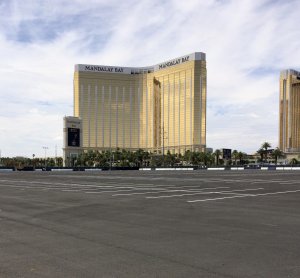
I took this picture in the 15-acre parking lot where the country music festival took place. The mass murderer was in a corner suite on the right side of the Mandalay Bay hotel tower in the middle of this photo. He shot through a broken window from an elevated position on the 32nd floor (he actually broke two windows, but the breeze blowing through between them slammed the door between the adjacent suites he was renting, locking him out of one).
Some of his victims were outside the fence, almost directly in line with the bad guy’s line of fire, on the west side of the parking lot, along Las Vegas Boulevard.
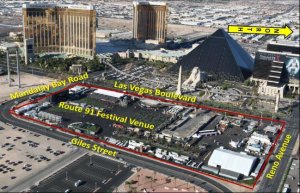
We call that being “in enfilade,” when the long axis of a group of people more or less lines up with the shooter’s guns. As opposed to “defilade,” where we are on the reverse slope of a hill or behind a bullet resistant wall or otherwise out of a killer’s direct line of fire.
But the people listening to the concert from outside the fence could at least run away. It’s very difficult for even trained marksmen with optics to hit a target moving at a sprint perpendicular to them.
The vast majority of the killer’s victims were hemmed in INSIDE the fence, and could not get away.
It would be too complimentary to call that bozo in the Mandalay Bay a “sniper.” A sniper is a marksman. Although the hotel was about 450 meters from the parking lot, the thousands of people within the perimeter fence provided an Area Target. I doubt he had the skill to hit any specific person he might have aimed at. Instead, all his victims were hit by bullets addressed “to whom it may concern.” He just poured bullets into the (literally) captive audience, and was bound to hit someone.
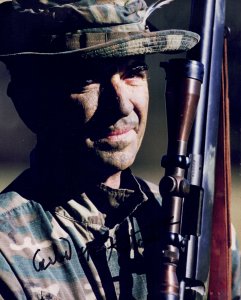
“The Shot” at Adobe Walls, Texas
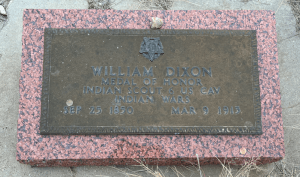
One of the most famous “precision” rifle shots in American history was actually aimed at an Area Target. In 1874, during the second battle of Adobe Walls in the northern panhandle of Texas, Quanah Parker and other Native American leaders were conferring on a hill about 3/4 of a mile away from the Adobe Walls trading post when a buffalo hunter named Billy Dixon (or one of his companions) knocked one of them off his horse.

Buffalo hunters were accustomed to murdering bison at considerable distance, and Dixon was one of the better shooters, perhaps the best marksman, among them. The Sharps buffalo guns they used were quite capable of hitting at stationary Point Targets at 1000 meters or more (as evidenced by shooting matches back east and in England during that era). Seeing and identifying a single individual at extended range without modern binoculars or a spotting scope would be another matter. Several Plains Indians were hit at considerable distances during the battle.
Most of the hunters were shooting a lot, often taking shots at great distances throughout the fight. Dixon may not even have been the one who made “the” shot, although Dixon is the one generally credited by contemporary sources as having accomplished that legendary feat of combat marksmanship.
Dixon said he was just shooting at the entire group, and that he was lucky to have hit any of them.
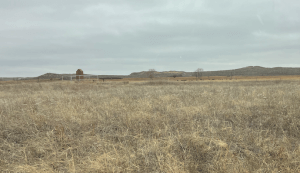
Not so lucky was To-hah-kah, the brave who (in some versions of the story) was hit by “the shot.” Some accounts say he was killed; others that the lead .50 projectile’s velocity was so spent after traveling that distance (accounts vary in range from 800 to 1400+ meters) that it merely stunned him. When To-hah-kah went down, the other warriors on the hill immediately scattered (infantry types call that combat dispersion), but they returned shortly after that to rescue him (or recover his body, depending on which version you choose to believe).
If this subject fascinates you almost as much as it fascinates me, you should get a life. Or, you can read more in
- T. Lindsay Baker’s and Billy R. Harrison’s Adobe Walls: The History and Archaeology of the 1874 Trading Post, or
- S. C. Gwynne’s Empire of the Summer Moon: Quanah Parker and the Rise and Fall of the Comanches, the Most Powerful Indian Tribe in American History, or
- James L. Haley’s The Buffalo War: The History of the Red River Indian Uprising of 1874
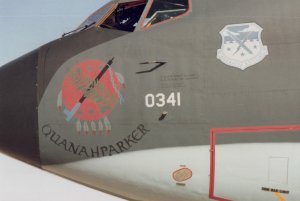
Above Ground Infrastructure = Area Targets
Fuel Tanks
The Route 91 Harvest Festival murderer also took several pot shots at a fuel tank at McCarran International Airport. The tank was about 600 meters away from his hide in the Mandalay Bay. His intent was apparently to cause a conflagration, either simply to enjoy the destruction or to lure firefighters into the kill zone of his ambush. Fortunately, jet fuel is mostly kerosene and not likely to be set ablaze with rifle fire; he did not succeed at causing a conflagration.
A pump at a gas station would be a Point Target; a gigantic fuel storage tank (or group of such tanks) for an airport is an Area Target.
Transformers and Other Electrical
One vulnerability that our nation has had for years, but has become more recognized and more significant recently (the farther we get from a day when most people could live without electricity for a few days), is our electrical infrastructure.
Recent craven attacks have demonstrated that even a few well placed rifle shots can have a massive, cascading effect on our power grid.
Smaller (cylindrical) transformers are Point Targets; larger, rectangular transformers or entire electrical substations might constitute an Area Target.
Pipelines
Nordstreams 1 and 2 might have taken underwater demolition teams or depth charges to destroy, but any bozo with a rifle can punch holes in an above ground pipeline.
Burying pipelines makes them less vulnerable to sabotage but more difficult to inspect and repair.
What Can be Done?
In the case of critical infrastructure, such as electrical substations and water wells, we can surround them with high, bullet-resistant walls or dirt berms that will at least protect them from projectiles launched from the same level.
In the service, we called that a revetment.
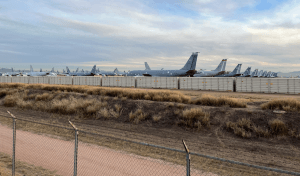
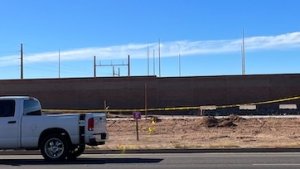

Movement
As individuals, we can make MOVEMENT our default response to incoming fire.
Movement is problematic if we are hemmed in by walls and furniture–which is most of the time. Running directly away is instinctive, but only gets us shot in the back. That response was programmed when the threats we faced had four feet and claws, or two feet and sharp sticks. As long as we remain in the railroad tracks of the assault–the line that runs between us and the killer–the bullets will eventually catch up with us.

The general rule if the bad guy is in your space (classroom or office) is,
Run away from a knife.
Run toward a gun.
Unless you can outrun a bullet, your only salvation will be in closing with the bad guy to get underneath or beside his barrel, and get it pointed in a safe direction (usually up).
If you are out in the open, run perpendicular or at a forward angle, forcing the shooter to traverse if he or she wants to track you.
If you are running away from a gun in a channelized space such as a hallway, try to zig-zag.
If you are in the open, with a short distance to your next cover, move fast and in a straight line.
Flushed Quail and Danger Area Crossings
When executing the “Run” option of Run / Hide / Fight, there are two schools of thought:
- The first is the “flushed covey of quail” theory. Proponents of this theory say if we all run at once in multiple directions, It creates what Deputy Bill Farmer calls a “shooter’s dilemma:” the killer will have to pick and choose. A percentage may be taken, but the majority, perhaps, will survive.
- The second school of thought might be termed the “litmus test” or “canary in the coal mine” theory.
One technique for those with the second worldview would be what they taught us in the military for crossing exposed ground: a Danger Area Crossing.
Let’s say you are on a patrol and you come to a wide road or gap between trees that you need to cross and can’t go around. It’s best to cross a road near a bend–preferably two bends–so you can’t be seen from far down the road, but that is another issue. If, at some point, your people must be exposed to cross that area, send two at a time, running as fast as they can.
When the first two get to the other side, they scout around. If they find no sign of the enemy, they then establish security on the far side and signal you to send two more people over, as fast as those two can run (at least while they’re exposed in the open). Then (only) two more. When they’re clear, two more. And so on.
If, at any time, the two in the open (it could be the very first two) start taking fire, don’t send any more people that way. It sucks to be them, but better only them than your whole patrol being caught in the open at once.
There are other methods, such as Bounding Overwatch, for traversing open terrain. A Danger Area Crossing is one that specifically keeps your people from being one big Area Target.
When might civilians need to use Danger Area Crossings, or to fan out like a Flushed Covey of Quail?
One example where you might utilize a Danger Area Crossing could be if you are caught up in some sort of civil unrest (such as the Los Angeles insurrection of 1992), if you and your friends are just trying to escape and evade out of the area. When you must cross an open street between buildings that might be exposed to potential wannabe “snipers,” move one or two at a time, and fast.
Another example might be if a killer uses fire (NOT gunfire; ACTUAL fire, the kind with flames) as a weapon to flush you into the open. In April of 2020, a Canadian attacked 16 separate locations in Nova Scotia. Most of his targets were rural residences. He would knock on doors and try to get people to come out of their homes. If they did, he shot them. If not, he set fire to their residences and tried to kill them when they fled. He also killed those from nearby residences responding to assist when their neighbors’ houses were on fire. He killed 22 in one night.
The use of fire against bunkered or entrenched personnel is as old as warfare. On 14 Jun 1878, Peppin’s posse set the McSween residence in Lincoln, NM on fire, with “Billy the Kid” and other Regulators inside. It continues to this day.
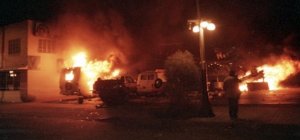
If a building full of people suddenly becomes untenable (and what a splendid word untenable is), the Flushed Covey of Quail philosophy might serve, especially if the building’s collapse or immolation is sudden or imminent. The Flushed Quail TTP is simple and instinctive. It’s very much “living in the moment.” Unlike the Danger Area Crossing, it does not require forethought or prior training or stepping back and taking the whole situation in to be executed in moments of near-panic. That is why everybody running at once is espoused by ICSAVE (Integrated Community Solutions to Active Violence Events) and AZCSN (the Arizona Church Security Network) in their ILIVED active violence response program.
However, it’s also instinctive for humans to bunch together when threatened. I have seen others do this and experienced it myself. I believe that instinct arose because there is strength in numbers. Four legged predators seek isolated prey–stragglers who fall behind the herd–and generally hesitate to attack a crowd. Again, these ancient instincts fail us against ballistic threats. If you use the Flushed Quail technique, spread out and keep on spreading–which is sometimes easier said than done.
In the Middle East, a popular terrorist TTP (tactic, technique, or procedure) is to send a suicide bomber into the middle of a crowded mosque, while killers wait outside the exits to ambush those who flee. That is identical to the initial plan of the Columbine High School killers, and similar to the TTP used at Jonesboro.
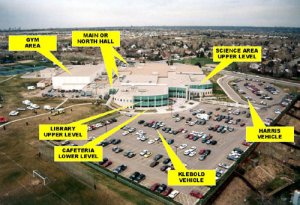
If at all possible, pause and look around before leaving cover and jumping out into a potential ambush.
If the fire is spreading slowly but inexorably (another splendid word), consider Danger Area Crossings out of multiple exits. If one route is compromised, the next pairs can flush from different exits.
Don’t Trap Your People in Big Groups Near Higher Ground
We can try to avoid being in crowds, but sometimes that can’t be helped.
What we can do is not place crowds of vulnerable people where they will be exposed to threats, in places where their ability to move / escape will be restricted.
I’ve conduced site security surveys for two schools recently that had their rally points for fire drills in spots that were both hemmed in by fence and lower than the surrounding terrain, creating perfect Area Targets. Fencing around the rally point may keep kids from wandering off, but it will also keep them from dispersing should that Area Target be threatened.
Better yet, let’s make the rally point somewhere defensible. Recall that students and teachers in Jonesboro took shelter from the killers in the school gymnasium.
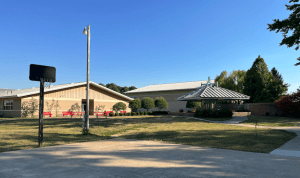
Why not make the gym our go-to rally point, unless the gym itself is on fire–which almost never happens with modern school construction?
Gyms also have a limited number of exits, but if somebody’s gonna shoot at you in a hard-sided (brick or concrete sided) gymnasium, he’ll already be inside the gym, where you have half a chance at getting at him, not taking pot shots at the group of you from a hundred meters or more.
–George H, career security & public safety professional
Ps.–Here at home, as good guys, other answers to the question of “How far away can you hit something with your rifle?” might include “How far away can I identify if it is a threat?” and “Is the threat in the open, in front of a wall, or in a crowd?”
We are responsible for the final resting place of every bullet we launch; the bad guys are not similarly restricted.
Refer to ASR Rifles and ARS Med Kits for further information about when it’s appropriate–yea, verily, desirable–to defend at distance, when it might be better to just seek cover, and how a rifle can be a viable defensive tool.
